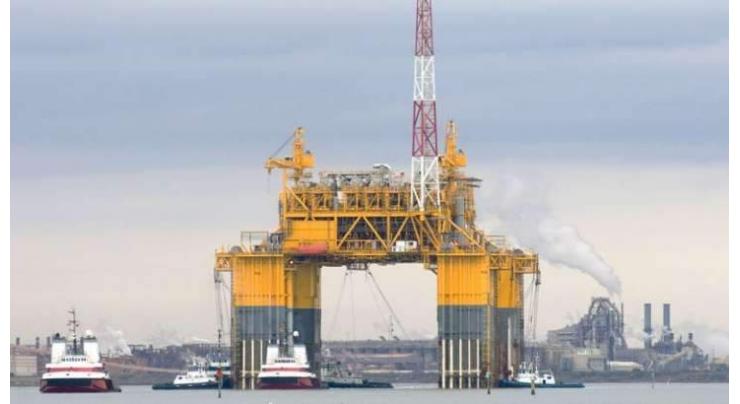
Oil Market Experiences Wildest Swings In 2018 As Geopolitics Rule Prices
Umer Jamshaid Published January 05, 2019 | 05:17 PM

The outgoing year proved to be a bumpy one for the oil market as it experienced the wildest price swings in years, dropping from over $85 per barrel to almost $50 per barrel over fears of the global oversupply that promise yet another challenging year for the Organization of the Petroleum Exporting Countries (OPEC) and other major oil producers attempting to stabilize the market
MOSCOW (UrduPoint News / Sputnik - 05th January, 2019) The outgoing year proved to be a bumpy one for the oil market as it experienced the wildest price swings in years, dropping from over $85 per barrel to almost $50 per barrel over fears of the global oversupply that promise yet another challenging year for the Organization of the Petroleum Exporting Countries (OPEC) and other major oil producers attempting to stabilize the market.
Since 2016, major oil producers, including OPEC and Russia among 9 other non-OPEC states, have been actively cooperating to reign over oil prices and avoid the scenario of 2014, when oil oversupply caused prices to plunge from $115 per barrel in June 2014 to less than $30 per barrel in January 2016. To show they were serious about the ongoing cooperation, the OPEC-non-OPEC steadily overcomplied with their agreement to decrease oil production by 1.8 million barrels per day (mb/d) and reached a remarkable monthly average conformity level of 107 percent for the first year of the Vienna agreement, which entered into force in January 2017 and is still effective until the end of 2018.
As a result, January and February of this year found the oil market in rather comfortable conditions with oil trading at some $65 per barrel and the glut in global oil inventories dropping from 340 million barrels to 100 million barrels. This caused the 25 oil-exporting nations to search for new targets to define market rebalancing other than the five-year average level of oil stocks that have slowly become irrelevant.
In April-May, oil prices reached their four-year maximum with Brent crude trading at $80 per barrel for the first time since November 25, 2014. The sudden increase was mainly prompted by geopolitical tensions, such as crises in Venezuela and Libya. The most significant trigger, however, was US President Donald Trump's pledge in May to reinstate sanctions against Iran in November that would target the country's oil industry and threaten export capabilities.
The aforementioned factors led to talk among oil industry executives of oil prices potentially reaching $100 per barrel over the course of 2018, something that would make US shale more competitive. Total President and CEO Patrick Pouyanne was the first to make such an announcement in mid-May where he argued that geopolitics was "dominating the market again," but he was met with opposition from BP Group Chief Executive Bob Dudley.
"There are people predicting that it will be $100 [per barrel], I don't think it will be $100 unless there are geopolitical restrictions to the flow of oil, I mean conflict, and I don't expect that," Dudley told Sputnik in May on the sidelines of the St. Petersburg International Economic Forum (SPIEF).
Consequently, in late May, oil prices dropped in light of reports about a possible relaxation of conditions of the OPEC-non-OPEC deal on oil production curtailment and returned to the $75-80 range.
TRUMP'S TWITTER DIPLOMACY RULING OIL FLOWS
In 2018, US President Donald Trump's active engagement in Twitter diplomacy was not limited only to his views on politics, but also on decisions of other major oil producers. While the United States was steadily increasing its own shale oil production and share in the global oil market, Trump was accusing OPEC of setting "oil prices artificially high."
To further demonstrate his influence, Trump announced over Twitter in late June that he had a phone call with Saudi King Salman bin Abdulaziz Al Saud during which he requested that Saudi Arabia increase its oil production "maybe up to 2,000,000 barrels" due to the unstable situations in Iran and Venezuela, and high oil prices. He concluded his tweet by saying that the Saudi leader had agreed, leaving his Twitter audience to wonder if Riyadh had agreed to boost output or that crude prices were indeed high.
The US president's calls for lower prices came a week after OPEC and non-OPEC decided themselves to increase oil production by about 1 million barrels per day to compensate for any potential oil shortage from sanctions-affected countries, such as Iran and Venezuela, and Libya due to internal turmoil. According to the group's analysis, the oil deficit could have stood at an unprecedented high level of 1.7 million barrels per day in the second half of 2018 if the 25 nations decided not to up their production levels, with additional oil coming mainly from Saudi Arabia and Russia.
"Oil producing countries are seeking the balance right now. The oil prices fluctuations are reasonable. I expect the range from $60 to $80 per barrel in the short term," International Energy Forum (IEF) Secretary General Sun Xiansheng told Sputnik.
Indeed, oil prices started growing more in the third quarter, and Brent crude even exceeded expectations by climbing over $80 per barrel for the first time in four years amid fears of Iran's oil exports zeroing out due to US sanctions.
However, the world economic slowdown together with a slower-than-expected oil demand translated into global oil inventories surprisingly rising again in mid-October, prompting OPEC and other oil producers to consider changing the course of action yet again, now by limiting oil production.
"I don't think Saudi Arabia will have much success if it tries to force other producers within the organization to cut their output, except for Kuwait and the UAE. Iraq will definitely resist and Iran's output is already subdued by sanctions. But Saudi Arabia needs the OPEC 'cover,' it has to do a balancing act between market requirements and its diplomatic relations with Trump's US," Ruba Husari, non-resident fellow at the middle East Institute (MEI), told Sputnik.
Nevertheless, as oil, both Brent and WTI, suffered the biggest monthly percentage declines in 10 years and rising production levels from the United States, OPEC and Russia continued contributing to the gradual trend of oil inventory build-up, not cutting oil production within the OPEC-non-OPEC group was no longer an option, but a necessity. Consequently, the 25 oil exporters agreed on December 7 to reduce overall production by 1.2 million barrels per day starting from the next year, with a view to signing the charter on future long-term cooperation in the first quarter of 2019. While Riyadh said it would cut production by some 500,000 barrels per day already in January, Moscow chose baby steps in its oil production decrease with the aim of decreasing output by a total of 228,000 barrels per day as part of the OPEC-non-OPEC deal. That, however, created further uncertainties and volatility to the market, moving Brent below $60 per barrel for the first time since October 2017 an
d leaving only Trump happily tweeting that it was "so great that oil prices are falling."
"Declarations of Russian Energy Minister Alexander Novak stated that the adjustment of Russian oil production for January would be 50,000 barrels per day. I understand Russia's adjustment will be gradual until they get to 230,000, but some say Novak is cheating the OPEC+ agreement. I think because they don't know or don't understand that the Russian adjustment will be gradual," a source in one of OPEC delegations told Sputnik.
PRICE COLLAPSE PROMISES CHALLENGING 2019
Meanwhile, oil prices continued to spiral down throughout December amid fears of OPEC-non-OPEC oil output cuts not being enough to beat oversupply in the global market in 2019.
"2019 will be challenging for OPEC especially as US shale oil is expected to add 1 million barrels daily following the addition of 1 mb/d this year. However, you can never predict what new elements enter into play. For example, Alberta province producers in Canada cutting crude production to deal with a pipeline and storage bottleneck will have an unexpected impact on the market for sure," Ruba Husari said.
On Monday, Brent fell further down by a whopping 6.23 percent to $50.73 per barrel, making it a very memorable Christmas Eve for traders. Nevertheless, at present, neither Russia nor Saudi Arabia see a reason for any emergency meetings, according to the Kremlin.
Although the majority of analysts and energy agencies downgraded their initial world oil demand outlook and oil price forecast for 2019, the general feeling is that the oil market will slowly rebalance closer to the second half of next year with oil prices averaging at $60-70 per barrel.
"Given Iran's absence and other market factors, the price of oil is likely to be in the 60 to 70 range but of course this is looking into a crystal ball. Other factors can change this pricing naturally. It is important for these states to break even when it comes to meeting the demands of their increasingly bigger state budgets," Dr. Theodore Karasik, a senior adviser at Washington-based Gulf State Analytics, told Sputnik.
The beginning of next year will see OPEC and non-OPEC gathering to monitor market conditions in February to decide on further actions, as well as potential annual talks between the organization and US shale oil producers in March during the CERA Week conference in Houston, Texas.
Related Topics
Recent Stories

Bismah Maroof announces immediate retirement from international cricket

Malala expresses unwavering support for Gaza people

Selection committee dissolved over Pakistan women cricket team's poor performanc ..

Punjab CM Maryam Nawaz in police uniform at Chung police center

Currency Rate In Pakistan - Dollar, Euro, Pound, Riyal Rates On 25 April 2024

Today Gold Rate in Pakistan 25 April 2024

Mired in crisis, Boeing reports another loss

Session Awarding Ceremony 2024 held at Cadet College Muzaffarabad

Austrian ski great Hirscher to make comeback under Dutch flag

Pakistan, Japan agrees to convene 'Economic Policy Dialogue'

FM Dar conveys deepest sympathy on torrential rains devastation in UAE

Spain PM Sanchez says weighing resignation after wife's graft probe
More Stories From Business
-
Mining giant BHP launches bid to take over rival Anglo American
13 minutes ago -
Gold rates up by Rs500 per tola to Rs242,500
1 hour ago -
Tokyo stocks end lower after Meta results
2 hours ago -
EXCHANGE RATES FOR CURRENCY NOTES
3 hours ago -
Foreign exchange rates
3 hours ago -

Currency Rate In Pakistan - Dollar, Euro, Pound, Riyal Rates On 25 April 2024
5 hours ago
-

Today Gold Rate in Pakistan 25 April 2024
5 hours ago -
Meta profits soar but costs of AI cause worry
6 hours ago -

Mired in crisis, Boeing reports another loss
14 hours ago -

Pakistan, Japan agrees to convene 'Economic Policy Dialogue'
15 hours ago -

British-Pakistani firm unveils $35 million luxury apartments for overseas Pakistanis in Islamabad
15 hours ago -

European stocks lose momentum after global rally
15 hours ago











